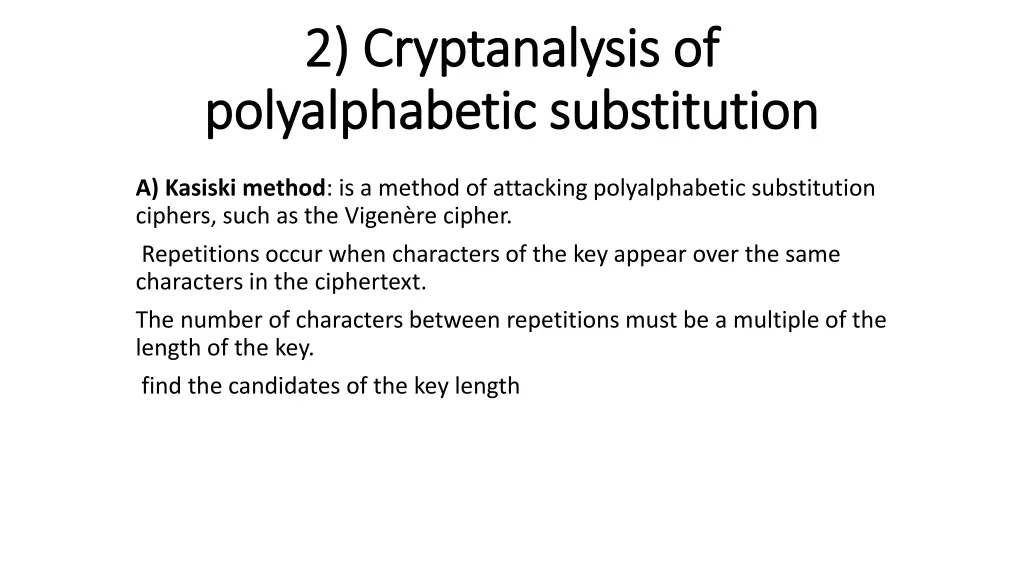
Cryptanalysis Techniques for Polyalphabetic Substitution Ciphers
Learn about the Kasiski method, a cryptanalysis technique for attacking polyalphabetic substitution ciphers like the Vigenere cipher. Discover how to identify key length candidates using repeated patterns and factors of differences between instances. Dive into understanding the Index of Coincidence (IC) and its calculation for deciphering encrypted messages. Improve your cryptoanalysis skills with practical examples and insights into breaking polyalphabetic substitution ciphers.
Download Presentation

Please find below an Image/Link to download the presentation.
The content on the website is provided AS IS for your information and personal use only. It may not be sold, licensed, or shared on other websites without obtaining consent from the author. If you encounter any issues during the download, it is possible that the publisher has removed the file from their server.
You are allowed to download the files provided on this website for personal or commercial use, subject to the condition that they are used lawfully. All files are the property of their respective owners.
The content on the website is provided AS IS for your information and personal use only. It may not be sold, licensed, or shared on other websites without obtaining consent from the author.
E N D
Presentation Transcript
2) Cryptanalysis of 2) Cryptanalysis of polyalphabetic substitution polyalphabetic substitution A) Kasiski method: is a method of attacking polyalphabetic substitution ciphers, such as the Vigen re cipher. Repetitions occur when characters of the key appear over the same characters in the ciphertext. The number of characters between repetitions must be a multiple of the length of the key. find the candidates of the key length
rely on the regularity of English: high frequency ending: th, ing, ed, ion, tion, ation, etc. beginning: im, in, un, re, etc. pattern: eek-, oot-, -our-, etc. word: of, and, to, the, with, are, is, that, etc.
Steps of Steps of Kasiski Kasiski method method 1) Identify repeated patterns of three or more characters. 2) For each pattern write down the position at which each instance of the pattern begins. 3) Compute the difference between the starting points of successive instances. 4) Determine all factors of each difference. 5) If a polyalphabetic substitution cipher was used, the key length
will be one of the factors that appear often in step 4. Example/ xugghr trtei mngth ggfkl rtrah ggfui fbdnc kmlph ggfty nbvcf? 15 25-15=10 2,5,10 25 40-25=15 3,5,15 40 40-15=25 5,25 Key length= 5 Example/vhvsspqucemrvbvbbbvhvsurqgibdugrnicjqucervuaxssr? 1 19-1=18 2,3,6,9,18 7 37-7=30 2,3,5,6,10,15,30 Key length= 3 or 6
Example/ The IC of the text THE INDEX OF COINCIDENCE would be given by: c(3*2)+ d(2*1)+ e(4*3)+ f(1*0)+ h(1*0)+ i(3*2)+ n(3*2)+ o(2*1)+ t(1*0)+ x(1*0) = 34 divided by N*(N-1) = 21*20 = 420 which gives us an IC of 34/420 = 0.0809
Example/The IC of the text BMQVSZFPJTCSSWGWVJLIO would be given by: b(1*0)+ c(1*0)+ f(1*0)+ g(1*0)+ i(1*0)+ j(2*1)+ l(1*0)+ m(1*0)+ o(1*0) + p(1*0)+ q(1*0)+ s(3*2)+ t(1*0)+ v(2*1)+ w(2*1)+ z(1*0) = 12 divided by N*(N-1) = 21*20 = 420 which gives us an IC of 12/420 = 0.0286 Homework EX/Find the IC for the following message: WKHUH DUHWZ RZDBV RIFRQ VWUXF WLQJD VRIWZ DUHGHVLJQRQHZDBLVWRPDNHLWVRVLPSOHWKDWWKHUHDUHREYL RXVOBQRGHILFLHQFLHVDQGWKHRWKHUZDBLVWRPDNHLWVRFRPSO LFDWHGWKDWWKHUHDUHQRREYLRXVGHILFLHQFLHVWKHILUVWPH WKRGLVIDUPRUHGLIILFXOW






















